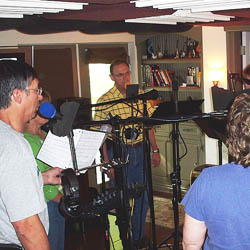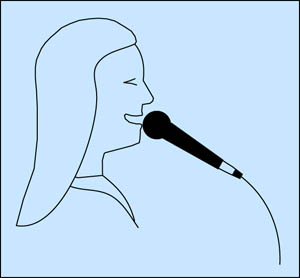
Each singer was about 2 inches from their mic’s diaphragm, and the microphones were 3 feet apart. So the isolation due to the inverse square law alone was 25 dB!
dB = 20 log D1/D2 = 20 log 2”/36” = -25 dB.
In addition, all the mics were angled apart. The “dead” rear of each mic’s cardioid pattern aimed at the opposite singer in the circle, increasing isolation of opposing singers.
Plus, each mic produced a lot of proximity effect—the bass boost that occurs in directional mics when used close to the sound source.
Because each singer was very close to his or her microphone, the mic boosed the low frequencies, but we rolled them off with EQ—reducing leakage in the process.
The increase in isolation from this technique was about 12 dB at 100 Hz.
In soloed tracks we measured about 30 dB of isolation, broadband. That’s using nothing but mic techniques—no baffles, no iso booths.
As a bonus, there was no phase interference between microphones. We followed the 3:1 rule—the distance between mics should be at least 3x the distance from each mic to its source.
This prevents comb filtering due to phase cancellations of two mics picking up the same source at different distances.
If the level difference between two adjacent mics exceeds 9 dB, phase interference is not audible.
Preventing breath pops
Doesn’t close miking result in breath pops? Normally it does, but consider this: Pop is worst at 3 inches from a microphone. As the singer gets farther or closer than 3 inches, pop diminishes.
When the singer’s lips touch their foam pop filter the pop is greatly reduced.
The foam windscreen disperses the pop turbulence very well when the pop occurs right at the windscreen’s surface.
Plus, we applied to each mic channel a 100 Hz highpass filter (low-cut filter) with an 18 dB/octave slope. Because pop occurs mostly at very low frequencies, using the highpass filter killed any remaining breath sounds.

